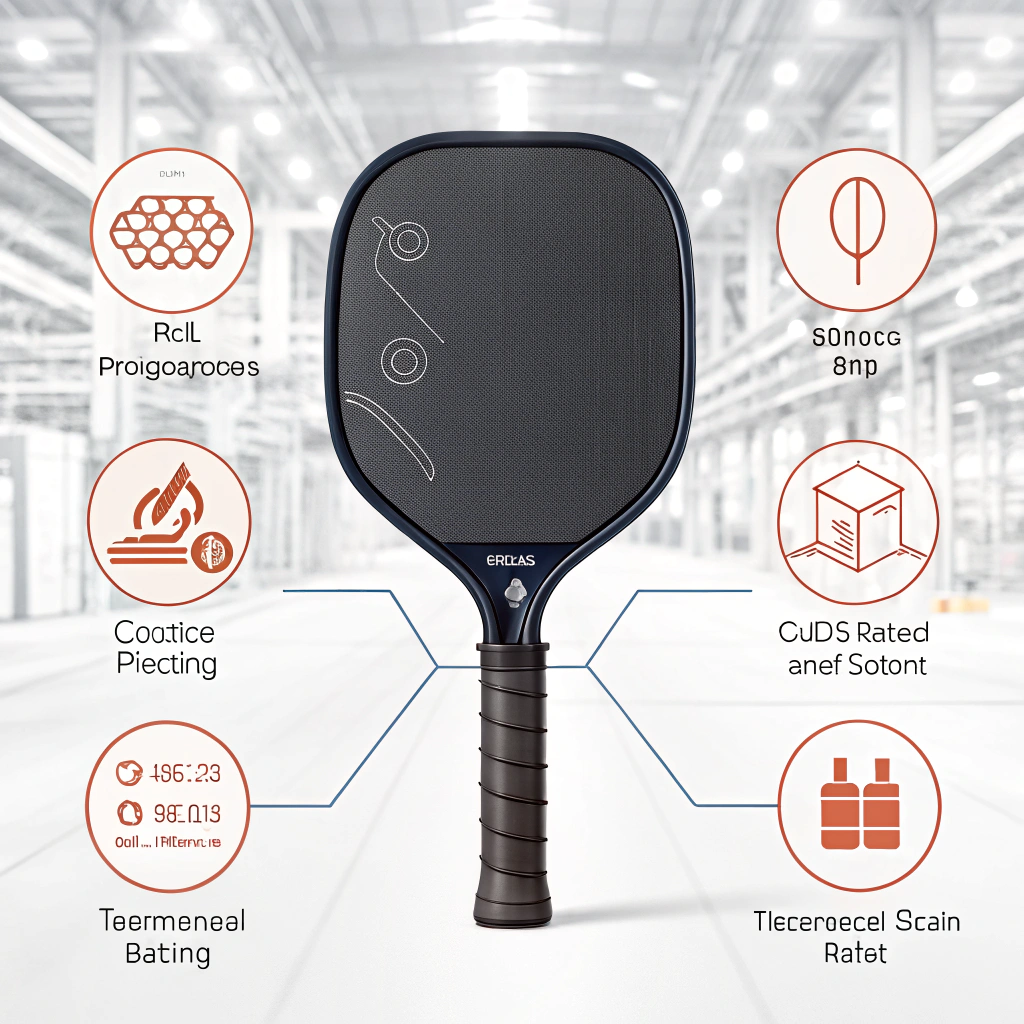Pickleball paddle manufacturing is evolving rapidly as emerging technologies and production techniques drive innovation and competitive market advantages. Advanced production methods such as hot pressing, cold pressing, and thermoforming are contributing to improved paddle performance, enhanced durability, and greater customization opportunities—key factors that business executives and production managers must consider when strategizing for future investments.
In today's fast-paced sporting goods market, particularly in the pickleball segment, manufacturers are increasingly turning to advanced production technologies1 to meet the dual demands of high performance and manufacturing efficiency. Recent trends in production methods and material innovations are redefining paddle design, resulting in equipment that caters elegantly to both recreational and competitive players. In this article, we explore key market trends in pickleball paddle manufacturing and offer actionable insights into production process optimization, material technology advances, and strategic forecasting for 2025 and beyond.
The pickleball industry has seen exponential growth over the past few years, driven by increased global interest in the sport and a surge in demand for premium sporting equipment. Manufacturers are not only facing the challenge of keeping up with demand but also the imperative to innovate. Among the most influential trends are:
- Integration of Advanced Materials: Manufacturers are now leveraging carbon fiber variants (such as 3K, 12K, and T300 carbon fiber) that allow for light yet strong paddles. These materials are critical in producing paddles that provide superior power and control.
- Adoption of Composite Technologies: The incorporation of composite materials2 made up of a combination of carbon fiber and fiberglass, bamboo cores, or even honeycomb cores3, is gaining momentum. This technology allows for optimized weight distribution and enhanced durability.
- Process Innovations: Techniques such as hot pressing, cold pressing, and thermoforming are being refined to produce paddles with optimal balance, precise control, and robustness.
The market forecast for pickleball equipment suggests that companies which leverage these new production innovations will stand out in a competitive marketplace. The convergence of material science, process optimization, and digital manufacturing4 is creating a blueprint for next-generation sporting equipment.
Manufacturing processes play a pivotal role in determining the end product's performance. At the forefront are three primary techniques: hot pressing, cold pressing, and thermoforming. Each has its own set of benefits and challenges.
Hot pressing involves heating the paddle materials and applying pressure to create a strong bond. This method is highly favored for its efficiency in mass production.
-
Advantages:
- High efficiency ideal for large-scale manufacturing.
- Produces robust paddles with excellent impact resistance.
- Ensures overall structural integrity which is essential for high-performance play.
-
Disadvantages:
- Potential alteration of some material properties, which may affect the tactile feel.
- Requires significant capital investment in specialized equipment.
Cold pressing shapes the paddle materials at room temperature using controlled pressure techniques. This process is especially useful where material integrity and tactile feedback are prioritized.
-
Advantages:
- Provides precise control over paddle thickness and architecture.
- Maintains the natural properties of materials, ensuring enhanced ball feel and responsiveness.
- Improved precision supports customization for targeted performance.
-
Disadvantages:
- Longer production cycles can constrain output.
- High quality, precision equipment is a necessity to maintain efficacy.
Thermoforming employs heat to soften materials followed by molding into desired shapes using specialized molds. This method is beneficial for producing paddles with intricate designs and varying thicknesses.
-
Advantages:
- Allows for complex, ergonomic designs and tailored material distribution.
- Enhances paddle stability by ensuring even distribution of stresses.
- Particularly suited to premium products and custom orders.
-
Disadvantages:
- Extended production times and higher equipment costs compared to other methods.
The table below summarizes each process based on key criteria:
| Production Process | Advantages | Disadvantages |
|---|---|---|
| Hot Pressing | High efficiency; robust product; strong impact resistance | Alters material properties; high initial costs |
| Cold Pressing | Precise control; maintained material properties; enhanced responsiveness | Longer cycle times; demands precision equipment |
| Thermoforming | Intricate designs; tailored material distribution; enhanced stability | Longer production time; high equipment costs |
Choosing the right technique depends on the desired balance between production efficiency, product performance, and customization needs.
Material advancements play a crucial role in the overall performance of pickleball paddles. For business executives and production managers, understanding these innovations is key to strategic planning.
Carbon fiber5 is a dominant material in high-performance paddles, prized for its strength-to-weight ratio and durability. The specific types used include:
- 3K Carbon Fiber: Known for its balance of strength and flexibility, ideal for paddles requiring higher rebound force. It enhances durability while reducing vibrations.
- 12K Carbon Fiber: Offers a smoother surface with greater hardness, perfect for paddles that demand extreme durability and high impact resistance.
- T300 Carbon Fiber: Renowned for its tensile strength, providing a balanced performance with both strength and lightweight properties.
These materials not only improve performance through enhanced responsiveness and control but also contribute to a longer lifespan, reducing maintenance needs and replacement cycles.
Composite materials combine different elements to deliver a range of performance benefits. Some popular combinations include:
- Carbon Fiber and Fiberglass Composite: Merges the toughness of carbon fiber with the flexibility and control of fiberglass, offering an optimal blend of power and precision.
- Bamboo Core Composite: Leveraged for its lightweight and impact-resistant properties, this material offers a distinct feeling on impact and increased longevity.
- Honeycomb Core Structures: Made from high-density polymers or pulp, honeycomb cores3 are prized for superior shock absorption, which reduces vibration and increases durability.
These innovations allow manufacturers to tailor paddles to specific player needs, creating niche products that can capture unique segments of the market.
The intersection of advanced production processes and material innovations creates significant opportunities for businesses in the pickleball manufacturing sector. By aligning production capabilities with emerging trends, manufacturers can not only meet current market demand but also future-proof their product lines.
- Market Forecasts: Industry reports suggest consistent global growth for pickleball, driven by rising participation rates. Forecasts indicate that companies investing in advanced production techniques and high-quality materials will secure a competitive edge as early adopters.
- Competitive Analysis: Companies like NEX Pickleball, already leveraging modern processes and superior materials, set a benchmark for quality and innovation. Their partnership with major brands like Joola and Selkirk exemplifies a strategic collaboration that enhances market credibility.
- Customer Expectations: Today's players demand equipment that delivers on performance, durability, and comfort. Meeting these expectations requires a thorough understanding of both material science and process engineering.
- Evaluate current production lines and consider integrating advanced processes such as cold pressing and thermoforming to meet specialized market requirements.
- Invest in material research to explore new composite solutions that can offer enhanced performance without significantly increasing production costs.
- Monitor global market trends and participant demographics, ensuring that product development strategies are aligned with evolving consumer preferences.
- Foster strategic partnerships within the sporting goods industry to leverage cross-industry innovations and gain access to emerging technologies.
- Establish rigorous testing protocols to maintain consistent quality and performance benchmarks, ensuring each paddle meets high-end standards before market release.
Through implementation of these strategic actions, businesses can not only maintain quality but also drive innovation that is both market- and technology-forward.
The evolving landscape of pickleball paddle manufacturing is a clear indicator that technologies such as hot pressing, cold pressing, and thermoforming combined with advanced material innovations are not just trends—they are becoming the industry standard. This convergence of efficient production methods and innovative materials heralds a new era of high-performance sporting equipment that meets the demands of both competitive athletes and recreational players. For business executives and production managers in the sports equipment sector, the time to invest in these trends is now. By staying ahead of the curve and embracing innovation, companies can ensure they remain competitive in a rapidly growing market.
Taking strategic actions informed by market intelligence and technological advancements will not only improve product performance but also enhance manufacturing efficiency, driving long-term profitability and sustainable market growth.
People Also Ask
Q1: How do advanced production techniques improve paddle performance?
A1: Advanced production techniques such as hot pressing, cold pressing, and thermoforming improve paddle performance by ensuring uniform material distribution, precise control over paddle thickness and structure, and enhanced durability. These methods help maintain the material's intrinsic properties for better ball feel and responsiveness while creating robust paddles that withstand high-impact play.
Q2: What are the benefits of using composite materials in pickleball paddles?
A2: Composite materials, such as a mix of carbon fiber and fiberglass or the use of bamboo core composites, offer the benefits of enhanced power, better control, and reduced vibration. They allow manufacturers to balance strength and weight, create custom paddle designs, and ultimately deliver a superior playing experience that meets both competitive and recreational demands.
Q3: What market trends are driving pickleball paddle innovations?
A3: Current market trends driving pickleball paddle innovations include the rising global popularity of the sport, increasing consumer demand for high-performance equipment, and advancements in material science and production processes. Manufacturers leveraging technologies like carbon fiber advancements and process innovations position themselves well to capture growth in this competitive market.
-
advanced production technologies: Click to learn how integrating cutting-edge production methods can enhance efficiency and performance in manufacturing processes. ↩
-
composite materials: Click to explore the benefits and applications of composite materials in enhancing product durability and performance across industries. ↩
-
honeycomb cores: Click to read about honeycomb cores and their role in improving shock absorption and structural integrity in advanced manufacturing. ↩ ↩2
-
digital manufacturing: Click to discover how leveraging digital tools and automation enables smarter, streamlined production in modern manufacturing. ↩
-
Carbon fiber: Click to understand the properties of carbon fiber and how its high strength-to-weight ratio is revolutionizing high-performance product design. ↩







